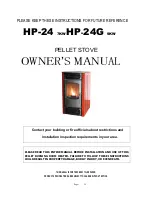
• Petroleum Coke
Never burn petroleum coke as this
burns at a very high temperature and its continued
use will almost certainly cause irreparable damage to
components such as the grate, baffle plate and fire-
fence.
• Bituminous House Coal
is not recommended
because it produces excessive soot deposits, which is
not good for the environment, and thus considerably
increases the need for frequent cleaning of the stove
and flue system.
• Household Rubbish
Printed matter (excluding very
small amounts of newspaper for starting the fire),
plastic, rubber, lacquered or impregnated wood,
plywood, chipboard and household rubbish, such as
milk cartons, should also be avoided. During
combustion some of these materials may develop
substances which could be hazardous to your health
and be harmful to the environment.
• Flammable Liquids
Never use methylated spirits,
petrol or other highly inflammable liquids for
lighting the fire as these could cause an explosion
in the confined spaces of the fire chamber.
UNDERSTANDING HOW
DIFFERENT FUELS BURN
Wood and solid or mineral fuels (multi fuels) burn in
different ways and you will need to understand these
differences if you are a newcomer to wood burners
and multi fuel stoves.
Putting it simply, mineral fuels, such as coal or
smokeless ovals, need a flow of combustion air
through the bottom grate which is known as Primary
Air, whereas wood fuel works much better when its
combustion air is taken from above the grate. This
source of air is known as Secondary Air. Wood always
burns best on a bed of its own embers and the ashes
shouldn’t need to be riddled. Again mineral fuels
differ because they need combustion air from below
the grate and therefore the grate needs to be
regularly riddled to keep the air passage clear.
See the section below to help you understand how
to control the different types of combustion air that
wood and mineral fuels need.
Your new stove can burn very well, or very poorly,
depending on how you light the fire, how you refuel
the fire, and, of course, the type and quality of the
fuel that you are burning. A log moisture meter is a
cost-effective investment if you want to maximise the
efficiency of your stove and wood fuel.
Wear protective gloves when loading a burning stove
and place the fuel precisely where you want it in the
fire chamber by using heat-resistant tongs. Always
open the stove door gently to avoid unnecessary air
turbulence which could cause fly ash or small lighted
embers to be drawn from the fire chamber and
beyond the protective hearth.
14
The stove is
not
designed to be operated with the
door left open continuously – this will reduce its
operating efficiency and it will consume more fuel
very quickly and produce less heat.
CONTROLLING THE COMBUSTION AIR
Your Graphite Boiler stove has three simple-to-use air
controls:
1 Primary Air Control
This is the large control knob
in the centre at the base of the stove front. Primary
Air is required when burning mineral fuels (and to
quickly aid the supply of air during the initial
combustion of wood). Using the tool provided, turn it
anti-clockwise to open and add combustion air.
2 Secondary Air Control
This is the sprung slider
control in the middle of the grille above the door.
Move it to the right for the maximum supply of air
and to the left to limit this supply. Secondary Air
is needed when burning wood and is not usually
needed when burning mineral fuels (unless it is to
maximise the air supply to aid the initial combustion).
3 Thermostat Control
Zero is closed and 8 fully
open. This adjusts the temperature of the water
leaving the boiler from low when closed off (approx
50ºC) to high (approx 90ºC) by controlling part of the
combustion air supply to the fire chamber.
The effectiveness of adjustment will involve the
interaction of the Primary and Secondary Air supply
The Primary Air Control
The Secondary Air Control
Summary of Contents for GR910-B
Page 4: ...4 GENERAL DIMENSIONS ...
Page 22: ... 23 ...














































